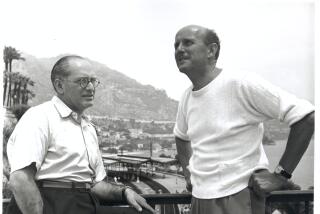It’s Been a ‘Life’-Enhancing Endeavor
- Share via
Michael Powell and Emeric Pressburger’s exquisite romantic fantasy “A Matter of Life and Death” may not be as well known to American audiences as their classic “The Red Shoes.” But the 1946 Technicolor release, known as “Stairway to Heaven” in the U.S., has a strong cult following.
Tonight, a newly restored print of the heavenly British love story starring David Niven and Kim Hunter will be unveiled at the Academy of Motion Picture Arts and Sciences’ Samuel Goldwyn Theater. The film, co-directed by Powell and Pressburger, was restored by the Academy Film Archive and Sony Pictures Entertainment, in collaboration with the British Film Institute’s National Film, Television and Video Archive.
“It is a great film,” says Michael Friend, director of the Academy Film Archive. “It’s a very lyrical and different film from the ones we watch today. The first part of the film is based on the philosophical poets of England. The entire sense of the film is kind of taken out of that kind of work--the idea of love transcending death.”
This restoration actually is the second one done on “Matter of Life and Death,” which was Powell’s personal favorite. The British Film Institute did some restoration on the film previously; that version is what audiences saw five years ago when the film was re-released theatrically.
First Restoration Could’ve Gone Further
But, says Grover Crisp, vice president of film restoration for Sony Pictures Entertainment, that British Film Institute restoration could have gone further. “The audio was not really restored,” he says. “It was more or less rerecorded. The other thing is that they did not go back to the original picture negative to do whatever new work needed to be done. They were relying on some older material that had been made quite some time ago.”
So Sony, which is in the process of restoring its classic films, earmarked “Matter of Life and Death” for a further sprucing up. “It is a film that is very dear to a lot of people’s hearts,” Crisp says.
Niven, at his dashing best, plays Peter Carter, a brave RAF squadron leader who is the only man left in the cockpit of his bomber. Though his parachute is gone, Peter still plans to jump from the burning plane. Before he jumps, though, he makes radio contact with June, a British-based American servicewoman (Kim Hunter). Somehow, Peter survives his jump into the English Channel, then sees a woman bicycling on the beach who, as fate would have it, turns out to be June. It is love at first sight. However, Peter wasn’t suppose to live. Conductor 71 (Marius Goring), a heavenly escort, somehow missed him, and now he must travel to Earth to bring Peter back to “The Other World.”
All of the sequences on Earth are shot in glorious three-strip Technicolor; all of the heaven sequences are in black-and-white. Working with the Academy Film Archive and the British Film Institute, Crisp was able to bring the original three-strip Technicolor negative and audio tracks from London to Los Angeles.
“The audio restoration involved removing problems that had developed over time because of wear and tear on the tracks, things like pops and crackles,” says Crisp. “Since this really was the first time that anyone had really worked with the original negative in, I believe, two decades, we had a chance to try and figure out the best way to present the film.
“Obviously, for the color sequences, we had to recombine the negatives to make new prints, but the black-and-white sequences we printed off of one of the negatives, thereby lessening the problem of scratches and things like that.”
The black-and-white scenes now are a bit sharper and harder-edged than in the original. “It was a bit of a trade-off,” Crisp says.
For the Technicolor sequences, one of the goals was to smooth out the color timing, “which is to make sure the contrasts and the density are even and the shots flow well from one to the other in our quest to make sure we are being as authentic as possible.”
Back to the Original Cinematographer
To further ensure the authenticity of the color, Crisp contacted the film’s cinematographer, Jack Cardiff, who lives outside London. “I talked to him at length about things we were seeing in the prints that we were getting back from the lab in terms of which direction we should go with certain scenes. There are a number of ways you can make a scene look when you are working on it at a lab--a point of red here, a little lighter there. These are all judgment calls.”
Crisp even sent a print of the film to the Sony Pictures office in London so Cardiff could see it.
“He loved the color sequences and had one or two suggestions on two different little scenes,” Crisp says. “We have tried to accommodate him as best we could. We feel pretty confident it’s very much representative of the way it [originally] looked.”
Still, he says, no film being restored today will ever look the way it did when it was originally released. “It is not possible to have it literally look the same way because the technology of the print labs has changed. The film stocks have changed. You try to come as close as you can to the original and, hopefully, if the artist is around, to please the artist.”
* “A Matter of Life and Death” (a.k.a. “Stairway to Heaven”) screens today at 8 p.m. at the Samuel Goldwyn Theater, Academy of Motion Picture Arts and Sciences, 8949 Wilshire Blvd., Beverly Hills. Admission is $5. Information: (310) 247-3600.
More to Read
Only good movies
Get the Indie Focus newsletter, Mark Olsen's weekly guide to the world of cinema.
You may occasionally receive promotional content from the Los Angeles Times.











